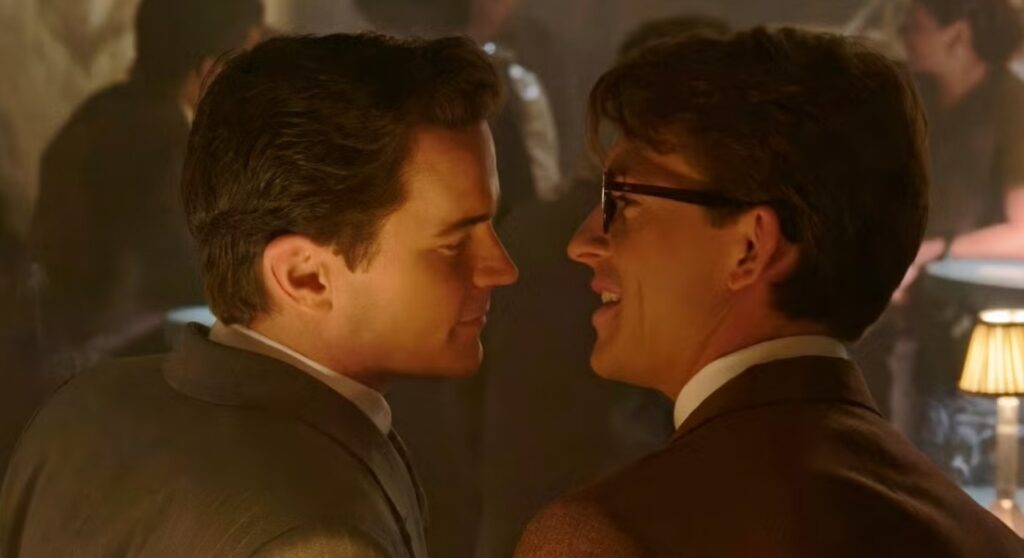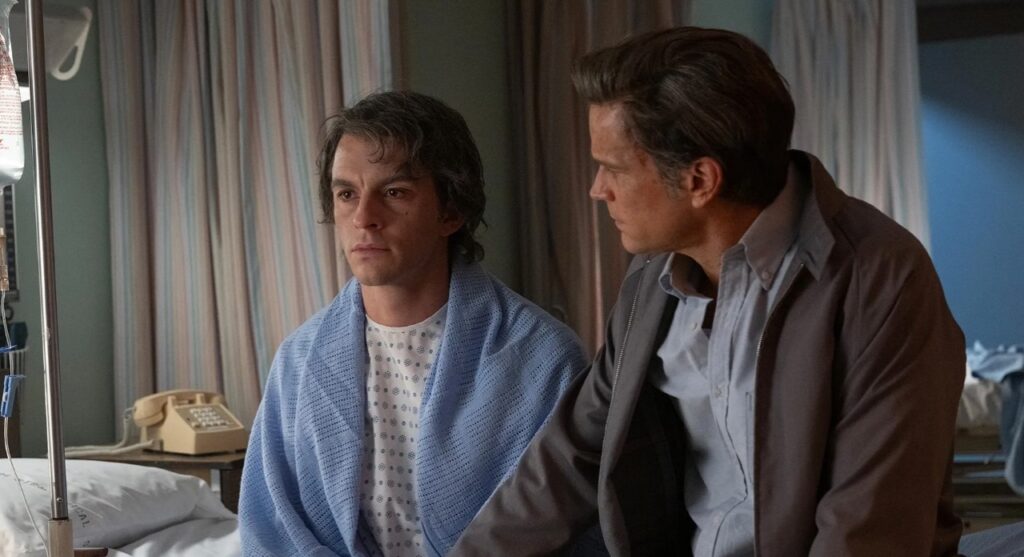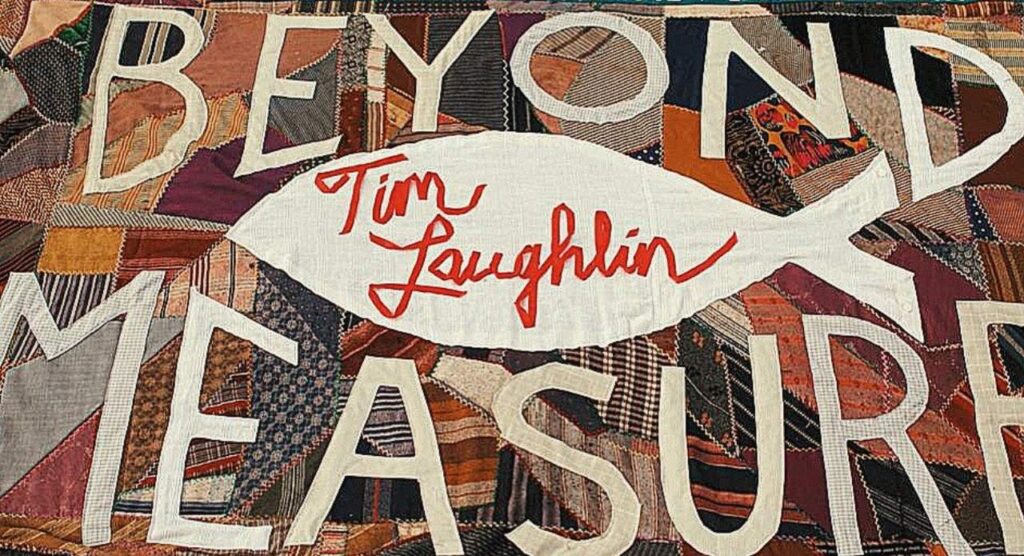Matt Bomer and Jonathan Bailey’s characters – Hawkins Fuller and Timothy Laughlin – from ‘Fellow Travelers’ aren’t real, but their journey of decades when the queer community was persecuted rings loud and true. Based on Thomas Mallon’s book, the story reveals the marginalization and atrocities endured by gays in the past century.
At the height of McCarthyism in the 1950s, the Lavender Scare wreaked havoc. Then the AIDS crisis marked a dark chapter for the LGBTQ+ community. And, how did that fight go? Most of it was tragic, just like the romance in the series. Here’s a breakdown of every real aspect of the fictional love story in ‘Fellow Travelers.’
How Lavender Scare Viciously Attacked The Gay Community In Reality

1950s America in ‘Fellow Travelers’ is a setting of secrets and fears. Hawkins lives a double life, and his liaisons come with a no-strings-attached agenda. But meeting Fuller changes that; it changes him. They both work in the US government while hiding their affair. It’s not just the societal scorn they fear, but the termination of their jobs as well. Reputations were tarnished on the basis of suspicion back then. Be it men or women, any sniff of homosexuality was investigated, interrogated, and ended up destroying lives and careers.
Related: ‘Mid-Century Modern’: Matt Bomer’s Old-Fashioned Sitcom Is The Hearty Gay Time We Deserve
At the forefront of this campaign was Senator Joseph McCarthy. His brainchild, the Red Scare, targeted communists. But in that garb was the Lavender Scare. His ilk believed that gays and lesbians were incapable of handling state secrets and were deemed traitors. They were harassed, questioned about intimacy, and yanked out of the political sphere. Many ran for their lives and resettled in small towns. McCarthy’s biggest supporter, Roy Cohn, who was a total hypocrite when it came to deposing the queer, created terror everywhere.
Hawkins traversed this tight rope and took female dates to parties. Fuller had to do the same, lest they be branded as “deviants.” It was a gay witch hunt. In one telling scene, a lesbian couple’s home is searched. Mattress being pressed on both sides, few cosmetics — nothing goes unnoticed. Unfortunately, this takes after real accounts.
Men were thoroughly under suspicion, too. When Hawkins is investigated despite his glorious army background, he has to go through a series of humiliating tests. His walk, talk… everything is examined. Then there’s a polygraph he beats by mastering his arousal. “You pass with the absence of guilt. Guilt cranks the machine,” he reveals the trick.
In all this mayhem, the office averaged one resignation a day and one suicide a week. The shame came for so many, not just at losing their position, but being exposed to their family and friends.
AIDS Epidemic Isn’t Just A Plot Device In Hawkins And Laughlin’s Tragic Romance

On screen, many movies and shows have explored the AIDS crisis of the 1980s. But here in ‘Fellow Travelers,’ it’s about the beginning of a new dawn. The hardships and heartbreaks abound. It was an ugly picture, but it was important. If the government didn’t fall for prejudice, countless lives would’ve been saved.
In the series, we see Laughlin battling the disease and slowly disintegrating into a shell of the person he used to be. This becomes the junction for him to reconnect with Hawkins, who had married and had kids, to save face and lead a “normal” life. The deterioration is mental and physical. Besides the outer signs, there’s helplessness at being robbed of his dignity that breaks Laughlin’s spirit.
In case you missed it: Top 20 Most Iconic And Influential LGBTQ Characters In TV History
However, he is fierce is demanding better from the government, which turned a blind eye towards AIDS. The message? “We’re not dying from AIDS. We’re dying from indifference.” This is reminiscent of the efforts of the AIDS Coalition to Unleash Power (ACT UP) in the real world.
‘Fellow Travelers’ Revisits Harvey Milk’s Assassination And Honors AIDS Memorial Quilt

Harvey Milk was the first openly gay man to be elected in California. He championed the queer community. ‘Fellow Travelers’ uses real-life 1978 news clips to show the catastrophe that ensued after his and Mayor George Moscone’s assassination.
Milk’s killer, former city supervisor Dan White, was acquitted of first-degree murder just six months later. Of course, there was outrage on the streets, and the White Night riots ensued. Today, the man is one of the greatest icons for the LGBTQ+ community.
Milk’s work was carried forward with courage and vigour by his protégé Cleve Jones. Perhaps his legacy’s shining achievement is the AIDS Memorial Quilt that appears in the last of ‘Fellow Travelers.’ Hawkins finally admits he loved Laughlin in front of his daughter and caresses the part where his lover’s name is stitched as “Beyond Measure.”
Related: Top 10 Queer Shows To Watch If You Liked ‘Heartstopper’
If we sift through the real history of the quilt, it was Jones’ idea. He had been organising candlelight marches in memory of Milk and Moscone. He asked his compatriots in this movement to etch the names of those they had lost to AIDS on their placards. These were, in turn, taped to the San Francisco Federal Building walls. The vision evolved into an assortment of names in a patchwork quilt that is now a 54-ton memento with 110,000 names on 50,000 panels. History forgets the revolutionaries too often, but this revolutionary tapestry is one for the ages.
‘Fellow Travelers’ celebrates the struggles and triumphs of queer love – past, present, and future.





